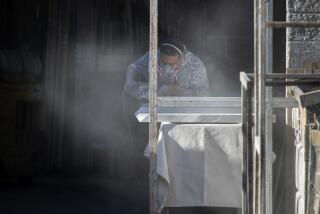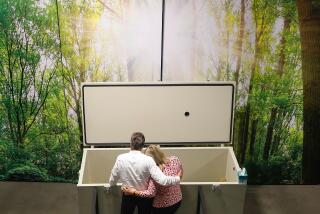Changing Lifestyles : Living Off the Dead Is a Dying Trade in Calcutta : For decades, the Bhattacharjee family has been the skeleton merchant for the world. But the use of plastic for laboratory skeletons has driven their bone business right into the ground.
- Share via
CALCUTTA, India — Bimalendu Bhattacharjee and his extended family of artisans and entrepreneurs once had connections all over the world. Every Christmas, they were flooded with greeting cards and toys from grateful customers in the United States, Europe and Australia. And their office, down a gritty narrow lane in a typically battered Calcutta residential district, was often filled with the foreign banter of a business that drew loyal clientele from as far away as Sydney, London and Pico Rivera, Calif.
But in this deeply impoverished city synonymous with death, dying and disease, the talk at Bhattacharjee’s M.B. & Co. was not just export quotas, excise tariffs and external markets. Mostly, it centered on skulls, bones and the current profit margins on Calcutta’s unknown dead.
For nearly half-a-century, Bimalendu Bhattacharjee and his family sold human skeletons to an outside world that never asked whence they came.
By all accounts, three generations of Bhattacharjees and the dozen or so other skeleton-supplying Calcutta families collectively earned tens of millions of dollars selling to universities and high schools in the West, where their wares became teaching tools as standard as biology textbooks and frogs for dissection.
For decades, Calcutta is believed to have been the world’s only human-skeleton supplier. In truth, if a biology classroom had a human skeleton hanging in the corner, it was a virtual certainty that it had begun its journey here, in a Calcutta alley or morgue or floating in the Ganges River, before passing through Bhattacharjee’s workshop.
Now, however, laboratory skeletons have much different origins--they are almost always made of plastic. The international trade in human skeletons, which once brought more than $1 million a year into Calcutta’s economy and the pockets of families like the Bhattacharjees, is all but, ah, dead.
And the story behind the rise and fall of this unique monopoly market is as much an illustration of India’s determined search for economic and national pride as it is a macabre testimonial to its sordid post-colonial past.
Indeed, throughout the world of commerce, there are few examples more stark of a long-flourishing trade with almost unlimited supply and demand that was killed virtually overnight by sheer public outrage and emotion.
For all its intrigue, though, the inside story of the skeleton merchants of Calcutta has long been as mysterious as it was controversial.
And it is only now, years after their livelihood and that of generations before them was finally and effectively banned by the Indian government in 1985, that the skeleton merchants led by Bhattacharjee agreed to open their secret world to a visiting Times reporter.
“Just remember,” as one Calcutta skeleton merchant put it, “they were all people once.”
Few know better than Bhattacharjee just how Calcutta’s dead came back to life in classrooms--and how that trade has come to an end. He was in the business for 42 years. As president of India’s Assn. of Exporters of Anatomical Specimens, he fought for it through 14 years of court battles and legislative hearings. And now, at 69, the sallow, bony, six-foot-tall Bhattacharjee said he was finally relieved to be able to discuss openly a business he no longer regards with either fear or favor.
“Still, I’m not very happy about all this. After all, it is in my blood that I took up this business,” he said. “But when the government is against it, how can we do it? They will arrest me. They will seize the goods. They will put me in the dock and send me to jail. It’s just not worth it anymore.”
At the peak of Calcutta’s human-skeleton trade in the late 1970s and early ‘80s, Bhattacharjee reckons that his company alone was exporting 2,500 skeletons a year. He charged about $150 apiece and made a 40% profit. His customers included a half-a-dozen American importers, all of which have had to quit or turn to plastic skeletons since the ban, he said. And each year, it seemed, there were more trying to join the trade.
“We were the biggest when we stopped,” he said. “But, of course, we weren’t the first.”
Calcutta’s human skeleton trade dates back to the height of World War II, when a London scientific-supply company could no longer find enough bodies in Britain to satisfy the demand of local medical schools and export markets abroad.
In British-ruled Calcutta, though, the company’s agents found not only a ready supply of unclaimed bodies suitable for the purpose but, more important, an entire community of low-caste Hindus whose sole and ancient role in life was handling corpses.
They’re called Doms, India’s keepers and handlers of the dead. For centuries, the Doms have manned the Hindu cremation pyres and prepared bodies for their sacred last rites, as they continue to do at India’s holiest funeral shrines and at the more modern government centers known here as “electric crematoriums.”
Like most in India’s complex caste system, which is legally banned but inscrutably followed, the Doms believe that their job is their inevitable destiny--albeit, one made a bit more palatable by their traditional belief that a Dom who carries a minimum number of corpses in his life will avoid Hinduism’s continual rebirths and go directly to heaven.
“Without the Doms, this trade never could have taken off as it did,” said Bhattacharjee, a man prone to the apparently inadvertent pun. “They were the backbone of it.”
And so it was that even after India’s independence from Britain in 1947, when strict protectionist laws barred foreign firms from competing here, men like Bhattacharjee and other Indian skeleton pioneers entered the trade on their own.
“For years, we ran everything above board,” he said. “No one advertised, but everyone knew it was going on. The Doms would bring us the unclaimed bodies from city hospitals or ones they found floating in the river. They would cut away the flesh, bring us the bones, and we would assemble them into fully articulated skeletons. Our customers would order them in quantity. Everything was fine until the first government ban came in 1976.”
It was during the two years of near-dictatorship known as the Emergency under former Prime Minister Indira Gandhi that skeleton exports were first prohibited in Calcutta. The ban came in response to longstanding complaints about the trade, in part from neo-nationalists who viewed it as degrading and partly from Calcutta’s Muslims, who bury their dead rather than burn them and who suspected that the skeleton dealers were little more than grave robbers.
When Gandhi and her Congress-I Party fell from power in 1977, the successor Peoples Party government sought to undo virtually everything she had done--including the skeleton export ban. But while reversing the ban under intensive lobbying by Bhattacharjee and his association, the new government added a strange stipulation.
“They said that for each body we turned into a skeleton, we needed a police certificate that said this body was collected legally,” Bhattacharjee said. “Well, technically, that’s never been done. The Doms collect the bones and how they get them, well, let’s just say the new order was a contradiction in terms.
“So then, we had to give bribes to the police each time we got a body. They’d ask for 100,000 rupees (about $5,200) for one certificate. We’d give them 5,000 rupees for several. Well, it wasn’t all on the up-and-up, but the business went on as usual.
“Then, in 1985, there was a tremendous hue and cry. We were publicly branded not only as grave robbers but as anti-national. Everyone was screaming about us, and we started to get a lot of bad stories abroad. This hurt India’s image.”
At that point, Bhattacharjee’s nephew, Surja Bhattacharaya, interrupted. At 35, the nephew represented the third generation of skeleton merchants. Despite the wealth the trade brought to his family, in 1985 he, too, soured on his profession.
“We were exporting these things strictly for legitimate medical purposes,” he said, recalling a story that appeared in a British newspaper that year, “and suddenly I see this picture of our skulls, with lights inside them, being sold as display items.
“The whole thing was being misrepresented. And it began to look to me like the same as the monkeys we used to export for science that were instead being used at test sites for atom bomb blasts. If you ask me personally, this skeleton business also was dehumanizing for India. We are not that poor anymore that we have to export dead bodies. We are exporting many things to many countries now.”
Slowly, even Bhattacharjee began nodding his aging head in agreement.
“It is true,” he said. “You must have a respect for the dead people. I even ask my old customers now, ‘Why doesn’t your country collect from your own cemeteries?’ And still, they are coming here haggling for bones, although most now know by now that this trade is banned for good.”
If India is no longer poor, neither, of course, are the Bhattacharjees. Surja Bhattacharaya and his cousin now spend their time playing the stock market and managing the extensive real estate holdings that he said the family neglected during the skeleton boom.
His old uncle has less to do and occasionally finds himself sitting with foreign friends reminiscing about his former competitors and talking about what they’re up to these days.
“Let’s see,” he began one recent day, “there’s Sourav--that’s Mr. Mazumdar, and he’s exporting shrimp and prawns now instead of skeletons. Then, let’s see, Fashino--that’s Mohammed Sayeed, and he’s exporting fish-catching items. You know, these fishing rods and reels and whatnot. There’s a bunch of others, you know, still waiting around hoping they lift this ban again someday, but of course they won’t.
“As for the Doms, you know, there are only a few hundred of them involved in this thing here, and almost all have been rehabilitated by the government and given jobs at the hospitals and medical colleges,” Bhattacharjee continued. “It’s the businessmen who want this to start up again, not the Doms. They had enough. Me? I am doing nothing. It’s good to be relieved of all these problems and, well, I’m getting used to doing nothing.
“As for the customers, we don’t hear from them much anymore. No cards. No, no toys. A few letters, maybe. Guess everyone’s just gotten used to plastic instead of the real thing. And, well, maybe in this case, it’s not all that bad.”
More to Read
Inside the business of entertainment
The Wide Shot brings you news, analysis and insights on everything from streaming wars to production — and what it all means for the future.
You may occasionally receive promotional content from the Los Angeles Times.










